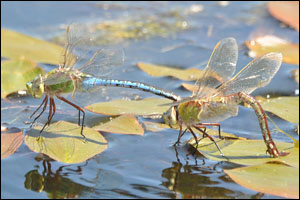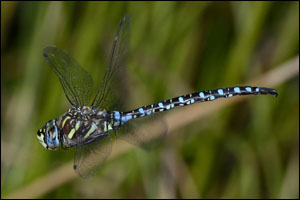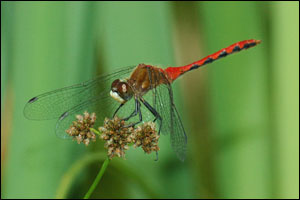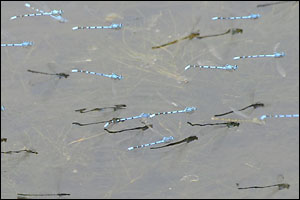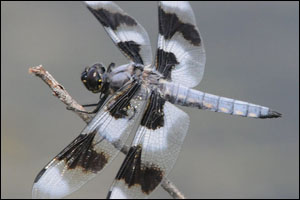home | internet service | web design | business directory | bulletin board | advertise | events calendar | contact | weather | cams

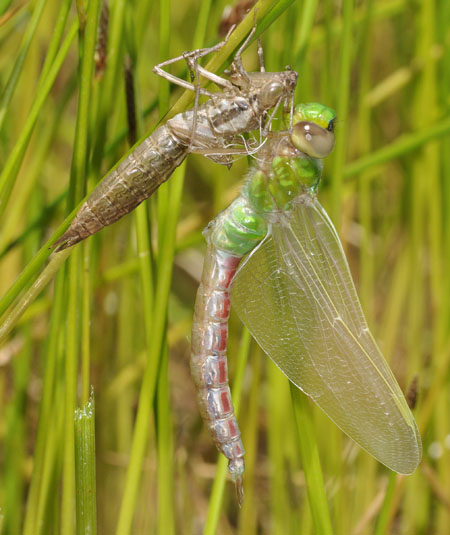 A Common Green Darner (Anax junius) emerges from its nymphal skin, which is called an exuvia. A Common Green Darner (Anax junius) emerges from its nymphal skin, which is called an exuvia.Extraordinary Odonates Dragonflies and damselflies—odonates—live and fly among the rich flora and fauna of the Methow River Valley of Okanogan County: 57 of Washington State’s 81 known species of dragonflies have been found in the county’s summer wetlands. Dragonflies and damselflies are common in the more open southern parts of the county in lakes in the midst of sagebrush, others only at high mountain lakes and bogs among the conifers, but most of them can be found in or within a short drive from the Methow Valley. Odonates are wonderfully unique. They have the best vision among the insects, their 20,000 simple eyes seeing all the colors we do plus ultraviolet, which we don’t. It’s a good thing for them, as they come in all colors. Blue is a predominant color, but our species can be mostly black, red or green or patterned with brown, gray, black, white, violet, yellow and orange. They are also the best fliers among the insects. Each wing moves independently, not only up and down but rotating on its axis. This allows them to glide slowly while flapping both pairs alternately, to speed up quickly by flapping them together, to stop on a dime and reverse direction, even to fly backwards to lift off a perch. There aerial agility is so varied that it has been discovered only through slow-motion photography. Odonates are all predators, not a vegetarian among them. Most of them eat quite small insects, including mosquitoes, but some specialize in larger prey such as butterflies or other odonates. The large darners and emeralds forage in the air like swallows, skimmers and clubtails and spreadwings fly up from a perch like a flycatcher, and most of the small pond damsels pick their prey from the substrate while in flight. But it’s probably their sex life that makes dragonflies among the most interesting of creatures. Males of many species are territorial, defending an area over the water against other males of the same species, just as in birds. The reason for this is that females come to the water only to breed and lay eggs, so if a male “owns” a territory, he has a chance to intercept one or more of these females as they arrive. Dragonflies aren’t subtle. When a male sees a female of his own species, he immediately grabs her with his legs, swings his abdomen forward, and clasps her head with three appendages at the tip. He then lets go with his legs and remains in flight while the female swings her abdomen forward and connects with structures under the second segment of his abdomen. At that point they are in the “wheel” position, and copulation takes place. They may mate in the air, sometimes only for a matter of seconds, or may land immediately. Sometime earlier, the male has bent his abdomen forward and filled structures called seminal vesicles in a hollow under his second segment. Damselflies do the same thing just after they have grabbed the female. These sperm are now ready to be transferred to the female during copulation. This way of mating, with sperm translocation taking place from male’s abdomen tip to its base, is unique to odonates. Check out a pair of butterflies mating tail to tail to see the difference. During copulation, the male deposits sperm in seminal receptacles on either side of the female oviduct. As the female produces eggs, they pass down the oviduct and are fertilized there, just before they are laid. So males give the females sperm, but the females fertilize their own eggs. A female can receive sperm from only one male and continue to lay fertile eggs for her lifetime, which, by the way, may be only a few weeks. But many of them probably mate more than once. If a male contacts a female that has already mated, he uses his copulatory organ to displace (scoop or flush out) any sperm from a previous mating and then replaces it with his own. This very interesting phenomenon was first described for damselflies, and we now know that it happens in a variety of other animals, even rodents. After mating, females are ready to lay eggs. In all damselflies but only darners (the big blue dragons) among the dragonflies, females have an ovipositor, a structure they use to deposit eggs in plant leaves and stems. Other dragonflies drop their eggs directly into the water, often in bunches. This is the best time to see females at the water for lengthy periods, and both oviposition methods are easy to observe. Because a subsequent mating will involve sperm displacement, males that have mated protect their genetic investment in a variety of ways. Some of them guard the female as she lays eggs, while others (most damselflies and certain dragonflies, especially the little red meadowhawks) stay attached, tail to head, in the tandem position during egg laying. And what happens to those eggs? Don’t forget that the brilliant dragonflies and damselflies you see are only a part of the life history of these fascinating insects. For a much longer time, up to a year or two, each of those adults was a nymph in the water. They are all aquatic until they emerge as adults, and they are easy to find in almost any wetlands. Take a tea strainer or a fine fishing net and scoop in the vegetation, and you’ll see not only odonates but many other aquatic insects and other strange creatures. This opens up a whole new world to a naturalist, and kids love it. If you find nymphs with swollen wing pads, they are about to emerge, and you can take them home, put them in a large jar or aquarium, add a screen or stick so they can come out of the water, and watch them emerge (some of them do so only at night). Any of the shallow, open lakes in the valley itself are worth visiting, for both adults and nymphs. Pearrygin Lake,(watch for a large pond on the way to the east campground), Big and Little Twin lakes, Davis, Campbell, Alta and others all have good populations. Higher up, check out Buck Lake or Blackpine Lake for a different set of species, and still higher, Roger Lake and Long Swamp have additional species, some of them characteristic of high latitudes to the north. There are also innumerable wetlands not yet visited by odonate enthusiasts; you might be the first. Stream species are uncommon in the valley, but don’t let that stop you from looking for them, as some of them are quite different from anything you will see at ponds and lakes. Did you know our state insect is the Common Green Darner? (photo at the top of the story) This big, beautiful dragonfly has a green thorax and blue abdomen and may be seen through the summer flying over lakes and ponds.
Dennis Paulson, Ph.D. was in the Methow Valley in July for the Methow Conservancy teaching about dragonflies. According to the North Cascades Institute website, he retired as the director of the Slater Museum of Natural History at the University of Puget Sound. Over decades, Paulson has researched birds and dragonflies and taught university and adult classes about birds, dragonflies, ecology and evolution. He is the author of over 70 scientific papers and a half-dozen books, including Shorebirds of the Pacific Northwest, Dragonflies of Washington, Shorebirds of North America: The Photographic Guide and Alaska: The Ecotraveler's Wildlife Guide. 8/17/2013 Comments
|
